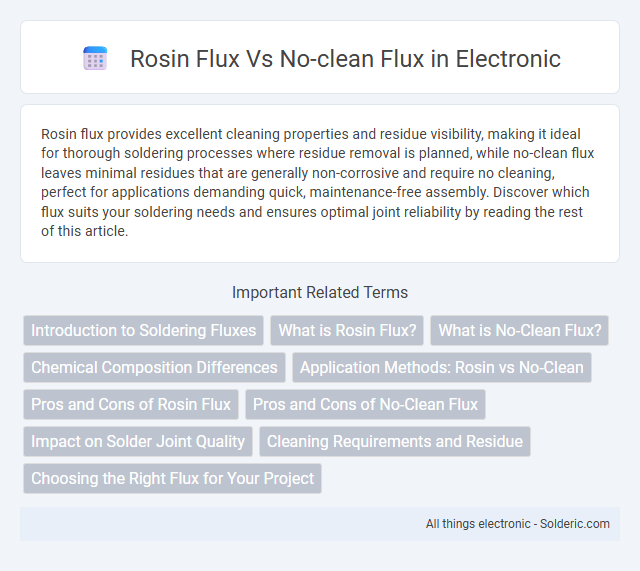Rosin flux provides excellent cleaning properties and residue visibility, making it ideal for thorough soldering processes where residue removal is planned, while no-clean flux leaves minimal residues that are generally non-corrosive and require no cleaning, perfect for applications demanding quick, maintenance-free assembly. Discover which flux suits your soldering needs and ensures optimal joint reliability by reading the rest of this article.
Comparison Table
| Feature | Rosin Flux | No-Clean Flux |
|---|---|---|
| Composition | Natural rosin resin and activators | Synthetic resin with minimal activators |
| Residue | Sticky, requires cleaning | Non-sticky, usually no cleaning needed |
| Cleaning Requirement | Mandatory post-solder cleaning | Optional or no cleaning |
| Corrosiveness | Potentially corrosive if not cleaned | Low corrosiveness |
| Application | Legacy electronics, repair work | Mass production, automated soldering |
| Reliability | High joint reliability with cleaning | Good joint reliability, no cleaning needed |
| Cost | Generally lower cost | Typically higher cost |
Introduction to Soldering Fluxes
Rosin flux and no-clean flux are essential soldering materials that enhance the wetting and bonding of metals during the soldering process. Rosin flux, derived from pine resin, is widely used for its effective oxidation removal and easy cleaning with solvents, ideal for electronics requiring thorough cleaning. No-clean flux residues are minimal and non-corrosive, eliminating the need for post-soldering cleaning, making it a practical choice for modern electronics and automated assembly lines.
What is Rosin Flux?
Rosin flux is a type of soldering flux derived from natural rosin, a solid form of resin obtained from pine trees, designed to improve the wetting and flow of solder during electronic assembly. It contains organic compounds that activate when heated, removing oxides and contaminants from metal surfaces, thereby ensuring strong, reliable solder joints. Unlike no-clean flux, rosin flux often requires thorough cleaning after soldering to prevent corrosion and residue-related issues on sensitive electronic components.
What is No-Clean Flux?
No-clean flux is a type of soldering flux formulated to leave minimal, non-corrosive residue that does not require cleaning after soldering, making it ideal for electronics assembly where post-solder cleaning is undesirable. It contains mild activators and synthetic resins designed to promote solder joint reliability while preventing oxidation during the soldering process. No-clean flux helps improve production efficiency by eliminating the need for solvent cleaning, reducing manufacturing time and environmental impact.
Chemical Composition Differences
Rosin flux primarily consists of natural rosin derived from pine trees, combined with activators like resin acids and organic acids to enhance solderability. No-clean flux contains synthetic resin bases and low-residue activators designed to minimize post-solder clean-up by leaving benign residues. The chemical composition differences influence flux activity, residue characteristics, and compatibility with various soldering processes.
Application Methods: Rosin vs No-Clean
Rosin flux is typically applied through brushing, dipping, or spraying, providing strong activation for solder joints, especially in electronics requiring thorough cleaning post-soldering. No-clean flux is often used in stencil printing, wave soldering, or precise dispensing, where minimal residue remains, eliminating the need for cleaning after assembly. Both flux types adapt to specific manufacturing processes, balancing residue management and solder quality.
Pros and Cons of Rosin Flux
Rosin flux offers excellent soldering performance due to its strong activation and residue protection, making it ideal for high-reliability electronic assemblies. However, the residue left by rosin flux is often sticky and can cause corrosion if not thoroughly cleaned, posing challenges for long-term device stability. You should choose rosin flux when superior joint quality outweighs the need for minimal post-solder cleaning.
Pros and Cons of No-Clean Flux
No-clean flux offers the advantage of leaving minimal residue that typically does not require cleaning, saving time and reducing labor costs in PCB assembly. It improves solder joint reliability by preventing oxidation during soldering, although residues can be slightly corrosive if exposed to high humidity or temperatures over time. You should consider potential residue visibility on sensitive electronics and evaluate whether your application can tolerate no-clean flux residues without compromising long-term performance.
Impact on Solder Joint Quality
Rosin flux enhances solder joint quality by effectively removing oxides and contaminants, ensuring strong metallurgical bonds and improved electrical conductivity. No-clean flux leaves minimal residue, reducing the need for post-solder cleaning while maintaining reliable solder joints, though it may not clean as aggressively as rosin flux. Choosing between rosin and no-clean flux depends on the specific application requirements for solder joint integrity and process efficiency.
Cleaning Requirements and Residue
Rosin flux typically requires cleaning after soldering due to its sticky, resinous residue that can cause corrosion or electrical leakage if left on the PCB. No-clean flux leaves minimal residue that is non-conductive and non-corrosive, eliminating the need for post-soldering cleaning in most applications. Your choice between these fluxes impacts maintenance time and long-term reliability of electronic assemblies.
Choosing the Right Flux for Your Project
When selecting flux for your project, rosin flux offers excellent cleaning properties and is ideal for high-reliability electronics due to its organic resin base that removes oxides effectively. No-clean flux leaves minimal residue after soldering, reducing post-process cleaning and making it suitable for sensitive components and high-volume production. Your choice depends on the balance between ease of cleaning, residue tolerance, and ensuring strong solder joints for your specific application.
rosin flux vs no-clean flux Infographic

 solderic.com
solderic.com